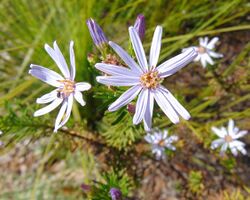Biology:Olearia tenuifolia
| Thin-leaf daisy-bush | |
|---|---|

| |
| Olearia tenuifolia growing in the ANBG | |
| Scientific classification | |
| Kingdom: | Plantae |
| Clade: | Tracheophytes |
| Clade: | Angiosperms |
| Clade: | Eudicots |
| Clade: | Asterids |
| Order: | Asterales |
| Family: | Asteraceae |
| Genus: | Olearia |
| Species: | O. tenuifolia
|
| Binomial name | |
| Olearia tenuifolia | |
Olearia tenuifolia, commonly known as the thin-leaf daisy-bush,[2] is a small shrub with narrow leaves and clusters of blue, deep mauve to purple flowers.
Description
Olearia tenuifolia is a shrub to 2 m (6 ft 7 in) high with scattered leaves arranged alternately along the stem. The leaves are linear shaped, 5–35 mm (0.20–1.38 in) long, 1–2.5 mm (0.039–0.098 in) wide, pointed at the apex, margins smooth or toothed and distinctly rolled under, both surfaces glandular. The flowers are mauve, purple or blue with a yellow disc floret, borne singly or in loose clusters at the end of branches on a peduncle 30 mm (1.2 in) long. Flowering may occur anytime throughout the year and the fruit is a dry, silky achene.[2]
Taxonomy and naming
Olearia tenuifolia was first formally described in 1867 by George Bentham and the description was published in Flora Australiensis.[3][4] The specific epithet (tenuifolia) means "slender".[5]
Distribution and habitat
Thin-leaf daisy-bush grows in New South Wales in woodland, mallee and sclerophyll forests mostly in rocky locations south of Dunedoo and west of Griffith. In Victoria it is considered rare and grows in rocky, dry locations in the Licola Creek and Valencia Creek area, and the upper Buchan River valley and Pine Mountain district.[2][6]
References
- ↑ "Olearia tenuifolia". Australian Plant Census. https://biodiversity.org.au/nsl/services/apc-format/display/106932.
- ↑ 2.0 2.1 2.2 Lander, N.S. "Olearia tenuifolia". Royal Botanic Garden Sydney. https://plantnet.rbgsyd.nsw.gov.au/cgi-bin/NSWfl.pl?page=nswfl&lvl=sp&name=Olearia~tenuifolia.
- ↑ "Olearia tenuifolia". Australian Plant Name Index. https://biodiversity.org.au/nsl/services/rest/instance/apni/537127.
- ↑ Bentham, George (1867). Flora Australiensis. 3. p. 486. https://www.biodiversitylibrary.org/item/41807#page/494/mode/1up. Retrieved 19 April 2022.
- ↑ Sheather, Warren; Sheather, Gloria (27 May 2020). "Olearia tenuifolia". Australian Plant Society NSW. https://resources.austplants.com.au/plant/olearia-tenuifolia/?gclid=EAIaIQobChMIr7LnzKif9wIVVSUrCh1nWAsKEAAYASAAEgKzDvD_BwE.
- ↑ "Olearia tenuifolia". Royal Botanic Garden Victoria. https://vicflora.rbg.vic.gov.au/flora/taxon/04611575-8a25-44d2-83dc-21cdf5b8ed3a.
Wikidata ☰ {{{from}}} entry
 |

